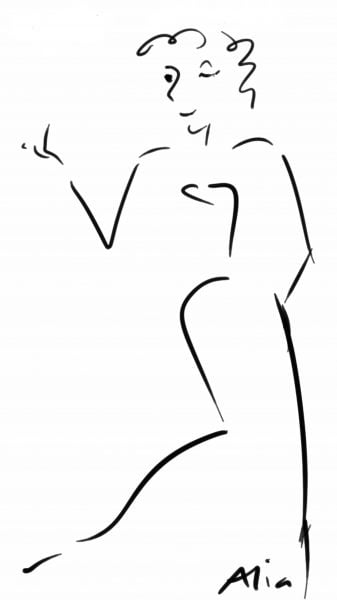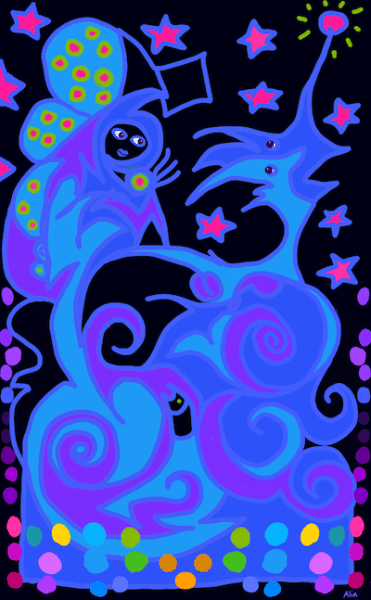A while back, someone asked me to “focus on the state of mind of the dancer when she improvs and techniques.” I think this asks about the difference in mind space between improv and technical practice. I can only speak for myself, but this is what I find.
Many years ago, I danced at a Dowser’s meeting. It was a brightly lit room and everyone stared at me very hard. They weren’t mean, they were just paying attention. But it rattled me; I felt self-conscious and never relaxed into the moment. Later, one of the women told me briskly, “Your spirit guide is an Egyptian woman. I could see her behind you. And you think too much when you dance.” She sure was right about the thinking.
At that time in my dance, embodiment was hit or miss. I sometimes got into the zone, but I could’t do it reliably. Like the Room of Requirement in Harry Potter, it turned up here and there, but go looking for it, and you come up empty-handed. It wasn’t until I got introduced to rhythmic breath that I started to reach that zone on a regular basis.

What is the technique headspace?
When I am teaching a regular class, for example, I am watching the students, thinking what’s next, organizing and planning. I am not so much in a state of flow. The same when I am leading a move across the floor (or following one). There’s a lot of mental errand running. If I am practicing technique, making or learning a move or a combo or whatever, I am in an intellectual headspace, observing, assessing, adjusting.
There’s nothing wrong with this.
As dancers, we want to improve. Talent has been defined as a reduction of errors. So we look to see where we miss the mark and fix it. Arms, hands, posture, openness, everything is measured, tested, tweaked. That’s fine and normal. But then we get to where we can let that level of attention go. My goal in practicing new things is to integrate them, so they become embodied, habitual, and I don’t have to think about them any more.
The problem is when analysis interferes with embodiment.
Dancing (as opposed to practicing technique) on stage or at home in assessment mode is a drag. Self-judging, self-doubt, etc are real buzz-kills. And the most random things threw me off! Silence, for example. I had a piece I started with my back to the guests for the first few bars, and then spun around. One time the silence that greeted that spin was deafening. I have since learned that silence is good (it means folk are paying attention), but this was so intense, I faltered and totally lost my groove—and never got it back for the whole show.
Dancers can be a terrible audience. They sit in the front row and squint at you. Seeing a frowning front row of dancers has tossed me out of my zone, as I wonder what I’m dong wrong and why they hate me. They don’t. They’re just trying to figure out what color is my underskirt, if my dress would fit them, where I got my earrings, if they know that step. But it used to really throw me for a loop.
Dancemeditation™ changed that for me.
Because now I had rhythmic breath. So when I got rattled, I could go back to my breath and re-immerse myself in the zone. I could reliably get there, and reliably stay there. Plus I matured as a dancer, and realized that silence was a compliment, and dancers were just interested (and maybe nearsighted). So I could more easily let go of my ever-ready self-doubt and enjoy my time on stage.
Keith Richards once said, “You don’t think on stage; you go into a zone.”
That’s exactly right. When I am in the zone, I notice everything—the coming waiter, the drunk at the third table, the audience. The other dancers in the wings, the band—but none of them have any emotional weight. They are logistical; they get dealt with intuitively rather than through mental effort. I notice them and let them go. I feel spacious and intense at the same time, fully pointed and completely loose. My body is in sync with the music and so is my breath.
The music is everything.
When I am in this state, there is a lot of room in the music. I feel relaxed. I take my time. It gives me everything I need. If all else fails, I map my body and face into a state of joy and dance that.
If I’m dancing on recorded music, I may have something I want to express. I may even have a score worked out—a loose choreography / structured improvisation of content and blocking. I rarely do sequences of moves—most of my choreographed dances are theatrical or conceptual arrangements. So I don’t have to limit myself to how I felt when I composed the dance (even when I make regular choreographies, I am always throwing things out in performance, because they are always too busy and I need more space). And I often dance to songs I’ve never heard just for that live music thrill.
I approach theatrical dance as structured improvisation.
I create a framework that contains any narrative, symbolism, even staging and movement highlights. So I always know what I want to say, but I don’t have to memorize a lot of details. Because it is just a framework! I can change bits, leave them out, or add them in on the fly. This allows me to be in The Zone, to be present and engaged, even with a fairly complex framework. I’ll be teaching this model soon in Wonderland: Theatrical Expression for Oriental Dance (an expansion of a segment from How to Create Dance Art).
With a live band, all I do is plan the set list with the musicians. And that may be an emotional arc rather than specific songs. Then I literally just go out and wing it. That is my favorite. At my best, I luxuriate in the music, phasing in and out of time, slow, at speed, slow. I don’t dance on every beat. I let a lot of music go by, and work in slow-motion. Anytime I get rattled, I go back to my breath and slow movement.
But what about a group dance?
Of course, as soloists, we have autonomy. But with group dances throwing things out just confuses the hell out of everyone else—unless you plan for it. You can compose group dances without set steps, using conceptual frameworks, so everyone knows the story arc and what’s going to happen when. Then you get to have a lot of fun onstage with your friends and the story takes on a lot of intensity and playfulness.
When I do group dances for students, they come up with all the steps. I am the art director, so I wrangle the order, repeats, etc. But they contribute to that, too. So we have fun dances they thunk up themselves—which means they learn faster, remember better, and generally have a much deeper investment—and spend less time thinking onstage.
An improv performance (or practice) is all about making space to be in the moment. So that is what we practice—getting reliably into the zone with breath, slow movement, and related strategies. In the zone, there is a sense of timelessness and being fully present. The sense of “I” disappears; the dancer feels connected viscerally to the music in a state of exalted oneness.
The Zone: That’s what we’re going for. That’s what we’re practicing.
All my love,
Alia
PS Here’s an Improv prompt.
One thing dancers fear is getting stuck in one move and not being able to think of anything else. Yet we hear of all these great dancers of the past who did maybe 4 moves their whole show and everyone loved them. So how do we get confident and comfortable with a limited palette?
Dance with only one move for a whole song. I know, right? Boring! But it’s not. The beauty of our dance is micro movement. That means each iteration of each move is different from any other—like snowflakes. So each figure 8 is different. You can vary the move by speed, size, force, height, or width, also by segmenting (starting and stopping), by alternating slow and fast, big and small, etc. And yes, you can change sides. But just one movement. No combinations. So just a figure 8, hip drop, circle, undulation, etc. Your choice.
Once you choose, woohoo! Just let anything come out, any part of your body, any kind of decoration. You can even do the exact same thing for the whole song–and feel just fine about it.
Music! Radio Bastet, all vintage belly dance vinyl. You can stream the podcasts at http://radiobastet.libsyn.com/. Just click on the little grey pod button to the top left of each episode.






No comment yet, add your voice below!